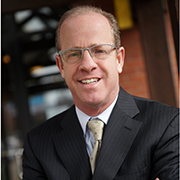Jerry Shafran developed a PowerPoint presentation that included screenshots of what he thought the insurance compliance software company he was launching would look like. He then started traveling to show it to compliance officers across the region. Even Shafran, who firmly believed he was solving a significant industry problem, was shocked by the reactions.
One woman in New Jersey stopped Shafran in his tracks to gather her colleagues in her office. “This is the best thing we’ve ever seen,” they told him.
Another woman at a Baltimore insurer looked at the same PowerPoint and, as Shafran describes it, emoted “I’ve been in this business 26 years and this is the best thing I’ve ever seen.”
Indeed, when you develop a product for people whose jobs are often looked upon with dread – even though regulatory compliance is meant to protect the consumer – the impact can yield great emotion and buzz. That’s largely why Shafran founded Compliance Assurance Corporation in 2005. In the last 18 months, the company has signed 21 new clients and its revenue increased 400 percent from 2011 to 2012. Revenue is expected to double again this year and Shafran is confident he’ll lock down more than 40 customers with his company’s rollout of Compliance 2.0, which he believes will be a game-changing approach to the industry.
What was the inspiration behind Compliance Assurance Corporation?
This isn’t my first endeavor. Another company I founded (Pittsburgh-based business solutions firm), Ceeva, was asked to help a local insurance company deal with what was then privacy and security regulations related to identify theft prevention. In the process of engaging the customer with Ceeva, we realized that insurance and financial organizations as a whole had a challenging regulatory landscape.
So we went up market and with the help of insurance firms, developed a product to help insurance companies deal with all the regulatory changes they need to deal with across their enterprise. The competitive landscape at the time, and still, was somewhat barren in that existing products in the marketplace did not in any way fulfill the requirements of the burgeoning regulatory compliance challenges. The tools that were in place weren’t solving the problems.
What was your biggest challenging in launching the company?
One was getting enough knowledge about the problem and a deep understanding of how the problem affected the customer so that the product I could build truly solved it. I spent a year on my own dime traveling to different insurance companies and learning about the problem.
The second challenge was finding early adopters. By their nature, insurance companies are risk averse. They have to be – it’s their business. The ones in the business a long time understand how to manage risk very effectively. That’s a hard environment for a startup to break into. Those that did take a chance on us were hopefully rewarded with a great, quality product at a price point nobody sees today.
So why is your product important?
Almost all regulation is adopted and enacted to protect the consumer. Non-compliance with these regulations often impacts the consumer. Almost universally, a customer would believe the insurer is doing what it is supposed to related to compliance. There’s an inherent expectation that we all have that companies we do business with are doing the right thing.
What’s your software’s big differentiator?
The single biggest one is we spent a year with the industry examining the problem before we wrote a line of code. That has translated into specific differentiators. We provide regulatory intelligence so we can take that regulatory change, and there are many of them – approximately 13 or 14 per business day – and translate it into a set of business requirements. These are suggestions. Insurance is regulated on state and federal level so in our country we have 52 jurisdictions counting D.C. and Puerto Rico. Each jurisdiction has the legal right to pass its own rules and regulations and they do frequently, much to our benefit. The complexity is what creates value for our product. We translate these changes from legal documents into business requirements and publish these requirements inside a piece of software to allow the insurance company to ensure they are performed. Once we’ve translated it, we allow customers to assign, manage, monitor and validate that those activities are being performed. None of our competitors do that. At best, our competitors will notify someone that an insurance law has changed.
What resources in the Greater Pittsburgh region has Compliance Assurance Corporation taken advantage?
We went to InnovationWorks very early on and they were one of our early funders. But in addition to providing us funding, they brought us expertise – a sounding board to go to. They gave us access to an internal recruiter and helped us recruit key talent, some of which was from outside the area. In addition we were introduced to Robin Hood Ventures, Delaware Crossing Investor Group and Mid-Atlantic Angel Group. All three of those were early funders and all three have seen what I’ll call good returns. They also brought connections and relationships. All have great expertise and are great organizations.
What ‘s the biggest challenge you’ve faced, personally or professionally?
When I was with Ceeva during the dot.com boom I made a decision to internally fund my first software development project. I put up $1.8 million of my own money, everything I had. I mortgaged the house, mortgaged everything. I did that in 2000. Let’s just say some decisions I made and the timing were not great. The dot.com bust was in its early stages and after 9/11 it was full-on. I ended up losing everything. The banks took the house, everything. At the same time that was happening, I had just turned 40, newly married for the first time, had a four month-old baby and the second one was on the way. I was very seriously considering closing Ceeva and returning to the workforce as an employee.
Thankfully my wife talked me out of that during an 18-month period where I went through a lot of soul-searching about my internal capability and willingness to continue, my newly developed family and whether it really made sense for me to continue down that path. I would not have done it or continued to do it without the support of my wife. With that, we kept Ceeva going and started up again and began to grow it again and in the midst of growing Ceeva was when we came upon solving this problem in the insurance industry.
What’s next for your company?
We are coming out with several new significant pieces of functionality that will allow our customers to take compliance and move it from being a business disabler, or having the perception of being a business disabler, to become a business enabler. We’re going to allow our customers with some of these new products to really enable growth compliantly. In my experience, which is frankly short in this industry, the underlying predominant feeling within the financial services industry is that compliance is an undervalued part of the business and compliance professionals feel that. They think about working within an organization where what you do is not valued as much as what someone else does. We call this Compliance 2.0. The goal of my organization is to develop programs, products and services that will allow compliance professionals to be more valued by their company and to become a more accepted part of their corporate family.
— by Joe Petrucci


http://www.complyfast.com/
2740 Smallman St. Suite 240 Pittsburgh, Pa. 15222


